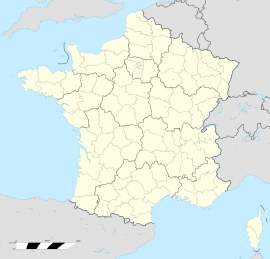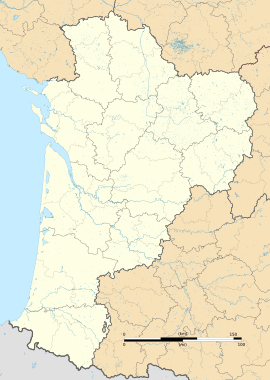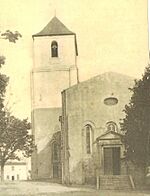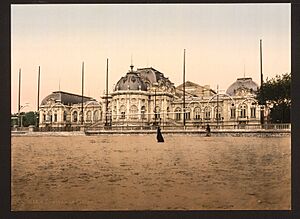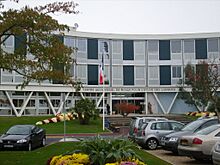Royan facts for kids
Quick facts for kids
Royan
|
||
|---|---|---|
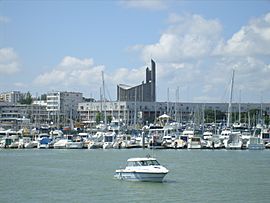
The port of Royan
|
||
|
||
| Country | France | |
| Region | Nouvelle-Aquitaine | |
| Department | Charente-Maritime | |
| Arrondissement | Rochefort | |
| Canton | Royan | |
| Intercommunality | CA Royan Atlantique | |
| Area
1
|
19.30 km2 (7.45 sq mi) | |
| Population
(2021)
|
19,029 | |
| • Density | 985.96/km2 (2,553.6/sq mi) | |
| Time zone | UTC+01:00 (CET) | |
| • Summer (DST) | UTC+02:00 (CEST) | |
| INSEE/Postal code |
17306 /17200
|
|
| Elevation | 0–35 m (0–115 ft) (avg. 20 m or 66 ft) |
|
| 1 French Land Register data, which excludes lakes, ponds, glaciers > 1 km2 (0.386 sq mi or 247 acres) and river estuaries. | ||
Royan is a town in the southwest of France. It is located in the Charente-Maritime area, within the Nouvelle-Aquitaine region. Royan is a major French coastal town. It is famous for its five beaches and a large marina. The town also has an active fishing port. In 2021, about 19,000 people lived in Royan.
Royan sits on the Arvert peninsula. It is at the mouth of the Gironde estuary, which is a large river mouth. This location made Royan important in history. Different groups like the Visigoths and Vikings wanted to control it.
During the time of the Reformation, Royan became a Protestant stronghold. King Louis XIII of France attacked and destroyed the city. Later, in the 1800s, Royan became a popular place for sea bathing. Many artists visited during the 1920s.
Sadly, Royan was heavily bombed during World War II between 1944 and 1945. The town was almost completely destroyed. After the war, it was rebuilt with a unique style. Today, Royan is known for its Modernist buildings from the 1950s. It is a popular place for tourists and culture, with many visitors each summer.
Contents
Royan's Location and Landscape
Royan is a seaside town in western Charente-Maritime. It is part of the old Saintonge region. The town is right by the Atlantic Ocean. It sits on the eastern side of the Gironde estuary, which is Europe's largest river mouth.
Along Royan's coast, you can see cliffs made of limestone. These cliffs are mixed with five sandy beaches. Locals call these beaches conches.
How Royan's Land Was Formed
The town of Royan is built on a calcareous rock plateau. This rock formed about 150 million years ago. The area also has marshes to the north and west. The estuary, cliffs, and beaches were shaped much later. This happened about 66 million years ago. It was due to the folding of limestone layers when the Alps and Pyrenees mountains were forming.
Getting Around Royan
Royan is well-connected by different types of transport.
Road Travel
Royan is about 65 kilometers (40 miles) from La Rochelle. This is the main city of the department. It's also about 98 kilometers (61 miles) from Bordeaux by freeway. Paris is further away, about 507 kilometers (315 miles). You can reach Saintes, an important historical town, in less than half an hour.
Train Travel
Royan has an SNCF railway station. It's the end of a train line that connects to Saintes, Angoulême, and Niort. From these cities, you can catch high-speed TGV trains to Bordeaux and Paris. There was also a tram system in Royan from 1890 to 1945. It helped people travel along the coast.
Airports Near Royan
Royan itself does not have an airport. However, there are several airports nearby. Rochefort-Saint-Agnant Airport is about 30 kilometers (19 miles) away. It offers flights to some European places. La Rochelle – Île de Ré Airport is about 70 kilometers (43 miles) away. For international flights, Bordeaux–Mérignac Airport is about 100 kilometers (62 miles) to the south.
Ferry Services
A ferry service crosses the Gironde estuary. It takes bicycles, cars, and trucks. The ferry goes to Le Verdon-sur-Mer in the Médoc region. The trip across the water takes about 30 minutes.
Royan's Weather
Royan has an oceanic climate. This means winters are mild and rainfall is not too heavy. Sea breezes help keep summer temperatures comfortable. Two main winds blow from the ocean. These are the noroît (north-westerly) and the suroît (south-westerly).
Royan gets a lot of sunshine, about 2,250 hours a year. This is similar to the sunny French Riviera.
In December 1999, Cyclone Martin hit the area. Winds reached very high speeds, causing a lot of damage. Buildings, trees, and port facilities were badly affected.
| Climate data for Royan | |||||||||||||
|---|---|---|---|---|---|---|---|---|---|---|---|---|---|
| Month | Jan | Feb | Mar | Apr | May | Jun | Jul | Aug | Sep | Oct | Nov | Dec | Year |
| Mean daily maximum °C (°F) | 8.5 (47.3) |
9.9 (49.8) |
12.1 (53.8) |
14.7 (58.5) |
17.9 (64.2) |
21.3 (70.3) |
23.8 (74.8) |
23.5 (74.3) |
21.8 (71.2) |
18.0 (64.4) |
12.6 (54.7) |
9.2 (48.6) |
16.1 (61.0) |
| Daily mean °C (°F) | 5.9 (42.6) |
6.9 (44.4) |
8.7 (47.7) |
11.1 (52.0) |
14.3 (57.7) |
17.5 (63.5) |
19.8 (67.6) |
19.6 (67.3) |
17.8 (64.0) |
14.2 (57.6) |
9.4 (48.9) |
6.6 (43.9) |
12.7 (54.9) |
| Mean daily minimum °C (°F) | 3.4 (38.1) |
4.0 (39.2) |
5.4 (41.7) |
7.4 (45.3) |
10.7 (51.3) |
13.7 (56.7) |
15.8 (60.4) |
15.7 (60.3) |
13.7 (56.7) |
10.5 (50.9) |
6.3 (43.3) |
3.9 (39.0) |
9.2 (48.6) |
| Average precipitation mm (inches) | 82.5 (3.25) |
66.1 (2.60) |
57.0 (2.24) |
52.7 (2.07) |
61.1 (2.41) |
42.9 (1.69) |
35.1 (1.38) |
46.4 (1.83) |
56.5 (2.22) |
81.6 (3.21) |
91.8 (3.61) |
81.8 (3.22) |
755.3 (29.74) |
| Mean monthly sunshine hours | 84 | 111 | 174 | 212 | 239 | 272 | 305 | 277 | 218 | 167 | 107 | 85 | 2,250 |
Royan's Past: A Look Back
Early Times and Ancient History
People have lived in the Royan area since very ancient times. Tools made from flint have been found there. The Santones, a Celtic group, were among the first people to arrive. Later, the Romans came. They grew grapes, farmed oysters, and made salt.
The Visigoths arrived in 418. They built defensive walls around Royan in 419. In 844, Vikings sailed up the Gironde river. They took everything they could find.
The Middle Ages
Around the 11th century, peace returned to the peninsula. Small areas ruled by lords and abbeys started to appear. Between 1050 and 1075, a priory (a type of monastery) called Saint Pierre was built. A small village grew around it. Another priory, Saint Nicolas, was built on the coast in 1092.
A small castle in Royan protected the Grande Conche beach. This beach was used as a harbor. By the late 11th century, many ships used the Gironde estuary as a stop. The local lord charged a tax for any boat that docked near the castle.
In 1137, Eleanor of Aquitaine married King Louis VII of France. Royan became part of the Duchy of Aquitaine, under the king's control. But in 1152, Eleanor married Henry Plantagenet. He became King Henry II of England in 1154. This meant Royan came under English rule.
The English king made the town's defenses stronger. He added strong walls and a solid tower. In 1232, the rules for taxes on ships were written down. On May 20, 1242, King Henry III of England landed at Royan with 300 knights. Even though he lost a battle nearby, the English kept control of Royan.
During the Hundred Years' War, in 1355, the Black Prince (the English heir) made Royan's defenses even stronger. Royan grew into a large town. By 1451, at the end of the war, the area was French again. However, the town was in ruins.
In 1458, Marie de Valois, the daughter of King Charles VII of France, married Olivier de Coëtivy. She brought the lands of Royan and Mornac with her. In 1501, Charles de la Trémoille became the Baron of Royan. Trade grew in the town. However, the town's walls made it hard to get around. A new area started to develop along the beach.
During the French Wars of Religion in the 1500s, many important leaders fought at Royan. These included Henri de Navarre, who later became King Henry IV of France. In 1592, Henry IV made Royan a marquisate (a special type of noble land). After the Edict of Nantes in 1598, Royan became a strong Protestant area.
King Louis XIII of France attacked Royan in 1622, but the town held strong. A second attack in 1623 caused great hardship. Many people left the city. The soldiers defending Royan had to give up. In 1631, Cardinal Richelieu ordered the town to be destroyed. The fortress was taken apart, and the ditches were filled. The city no longer had a church.
After the Edict of Fontainebleau in 1685, many Protestants left Royan. Some went to the Dutch Republic. Persecution continued under King Louis XV. A big storm in 1735 destroyed the harbor wall. It took until the 1800s for the harbor to be fixed.
The French Revolution's Impact
On December 22, 1789, the National Constituent Assembly changed how France was divided. They created departments instead of old provinces. The Charente-Inférieure department was formed in 1790. Royan became the center of its own canton (a small administrative area).
Royan elected a city council at this time. Daniel Renaud, a Protestant, was the chairman. Nicolas-Thérese Vallet of Salignac was the mayor. In 1790, a new law made the Catholic Church answer to the government. Priests in Royan and nearby areas refused to take an oath to this law. They were then forced to leave.
Across France, church properties were taken by the government. In Royan, a large convent was sold and torn down in 1791. Economic problems caused unhappiness in Royan. To help, patriotic clubs were formed. In July 1790, a ceremony was held in Saint Pierre church. People swore an oath to the new French Constitution.
In 1790, the mayor Nicolas-Thérese Vallet was replaced by François d' Aulnis de Puiraveaux. In 1791, Daniel Renaud was elected mayor. A pro-republican group, the Society of the Friends of the Constitution, started a branch in Royan. However, the period of the Reign of Terror did not affect the area much. Few local nobles were harmed.
Royan as a Seaside Resort
Work to pave Royan's streets began in 1816. It was finished in 1826. In 1819, the mayor made the first rules for sea bathing. In 1820, it was forbidden to wash animals in the sea where people bathed. In 1836, stairs were cut into the rock. This made it easier for passengers to get off boats.
By 1845, the Foncillon cliff was made part of Royan's port. In 1847, the town's first casino was built. Street lights were put in place in 1854. This was a time of great growth for Royan. Between 1850 and 1870, the number of tourists grew from 9,000 to 10,000. The town's population also increased.
Royan was a very popular seaside resort in the late 1800s and early 1900s. It had beautiful boulevards. In 1922, Royan was officially called a "summer resort." Many famous people visited, including the writer Sacha Guitry and the painter Pablo Picasso.
Royan's Destruction in World War II
During World War II, two German forts protected the Gironde estuary. These were some of the last German strongholds in France. On January 5, 1945, about 350 heavy bombers from the Royal Air Force (RAF) bombed Royan. The town was destroyed. Four bombers were shot down, and two others crashed.
The raid was ordered because people believed only Germans and their helpers were left in Royan. Later, in April 1945, American planes also bombed Royan. They used napalm, which finished the destruction. These bombings caused many civilian deaths.
Royan Today: A Modern Town
Royan was rebuilt as part of a city plan in the 1950s. It is a great example of Modernist architecture from that time.
Who Lives in Royan?
The people who live in Royan are called Royannais (for males) and Royannaises (for females) in French.
| Historical population | |||||||||||||||||||||||||||||||||||||||||||||||||||||||||||||||||||||||||||||||||||||||||||||||||||||||||||||||||||
|---|---|---|---|---|---|---|---|---|---|---|---|---|---|---|---|---|---|---|---|---|---|---|---|---|---|---|---|---|---|---|---|---|---|---|---|---|---|---|---|---|---|---|---|---|---|---|---|---|---|---|---|---|---|---|---|---|---|---|---|---|---|---|---|---|---|---|---|---|---|---|---|---|---|---|---|---|---|---|---|---|---|---|---|---|---|---|---|---|---|---|---|---|---|---|---|---|---|---|---|---|---|---|---|---|---|---|---|---|---|---|---|---|---|---|---|
|
|
||||||||||||||||||||||||||||||||||||||||||||||||||||||||||||||||||||||||||||||||||||||||||||||||||||||||||||||||||
| Source: EHESS and INSEE (1968-2017) | |||||||||||||||||||||||||||||||||||||||||||||||||||||||||||||||||||||||||||||||||||||||||||||||||||||||||||||||||||
Royan's Sister Cities
Royan has special connections with other cities around the world. These are called "twin cities" or "sister cities."
 Balingen, Germany
Balingen, Germany Gosport, United Kingdom
Gosport, United Kingdom Nafplion, Greece
Nafplion, Greece Annapolis Royal, Canada
Annapolis Royal, Canada
Places to See in Royan
Notre-Dame Church
Royan's old church, built in 1877, was destroyed in the 1945 bombing. A new, very modern church was built after the war. It was finished in 1958. This new church, Notre-Dame de Royan, is made entirely of reinforced concrete. It is seen as a masterpiece of modern architecture.
The church has a large oval main area, 45 meters (148 feet) long. It can seat about 2000 people. It has a walkway around the main area. The church is lit by large, diamond-shaped stained glass windows. These windows show the Stations of the Cross. The church was recognized as a historical monument in 1988.
Convention Centre
The Palais des congrès (Convention Centre) was built in 1957. It has a cubic design with interesting slanted stairs. A large glass wall offers views of the Gironde estuary. Gardens were later added under a clear cube. This building was also recognized as a historical monument in 2004.
Central Market
The Marché central (Central Market) was built in 1955. It is a round concrete shell with thin walls. It stands on thirteen support points around its edge, with no pillars inside. The market is 52.4 meters (172 feet) wide and 10.5 meters (34 feet) high in the middle. It became a model for other market buildings.
Learning in Royan
Royan has a language university called CAREL. It stands for Centre Audiovisuel de Royan pour l'Étude des Langues. Students from about 80 different countries come here to learn languages. It has many soundproof rooms, language labs, a library, and a TV studio. CAREL helps students prepare for important language exams.
Royan also has several junior high schools (collèges). These include Collège Émile Zola, Collège Henry Dunant, and Collège Sainte-Marie. For older students, there are senior high schools (lycées) like Lycée de l'Atlantique and Lycée de Cordouan.
Sports in Royan
The main sports stadium in Royan is the Stade d'honneur. It is located near the railway station. Royan has many other places for sports. There are two swimming pools, including an outdoor seawater pool open in summer. The town also has several gyms, a sports hall, and tennis courts.
You can also find a Basque pelota wall and a rugby ground. There is a golf course too. For water sports, there is a surf-club near Pontaillac beach. If you like racing, there is a karting circuit.
Nearby, in La Palmyre, you can find a racecourse and another 18-hole golf course. In 2017, Royan hosted the World Championships of Beach Ultimate.
Famous People Connected to Royan
Some well-known people were either born in Royan or lived there.
Born in Royan:
- Hadrien David (born 2004), a racing driver
- Pierre Dugua, Sieur de Mons (around 1558–1628), an explorer and colonizer
- Marie Léopold-Lacour (1859-1942), a feminist, journalist, and writer
- Eugène Pelletan (1813–84), a writer, journalist, and politician
- Jeanne Pelisson-Mallet (1873–1961), a painter
Famous people who lived in Royan:
|
See also
 In Spanish: Royan para niños
In Spanish: Royan para niños



